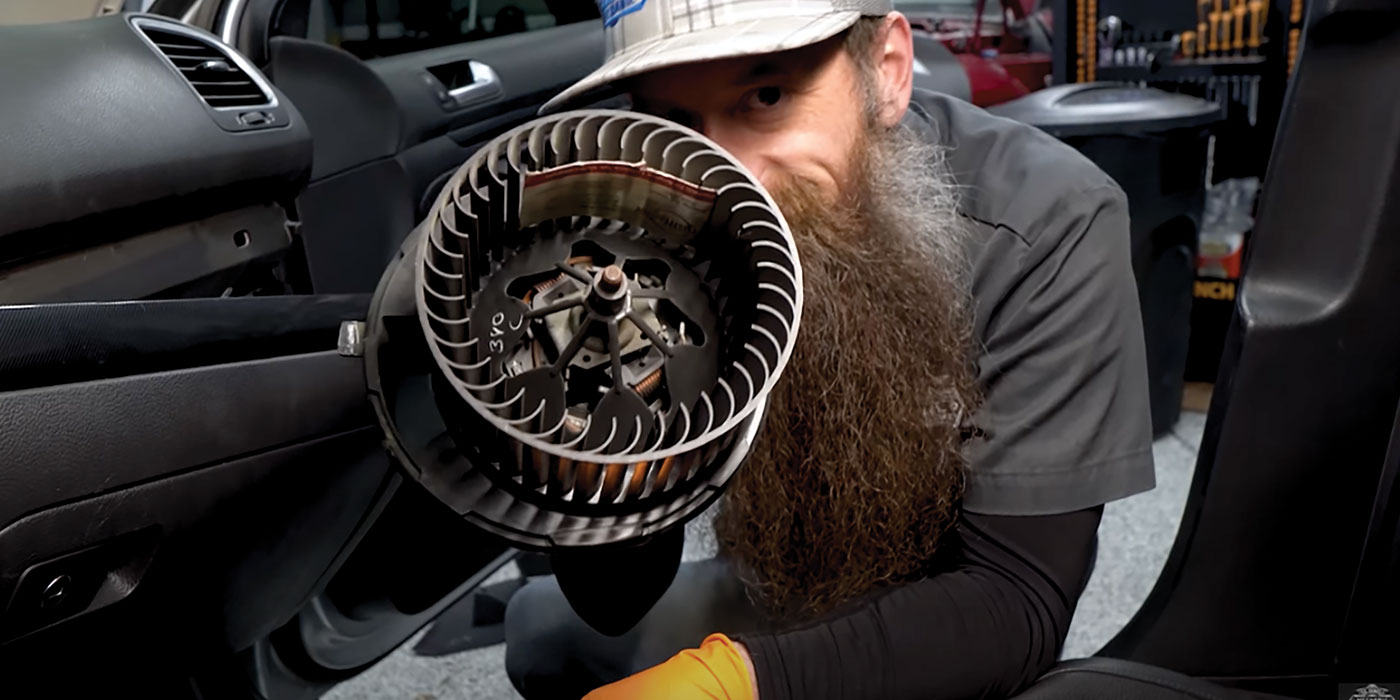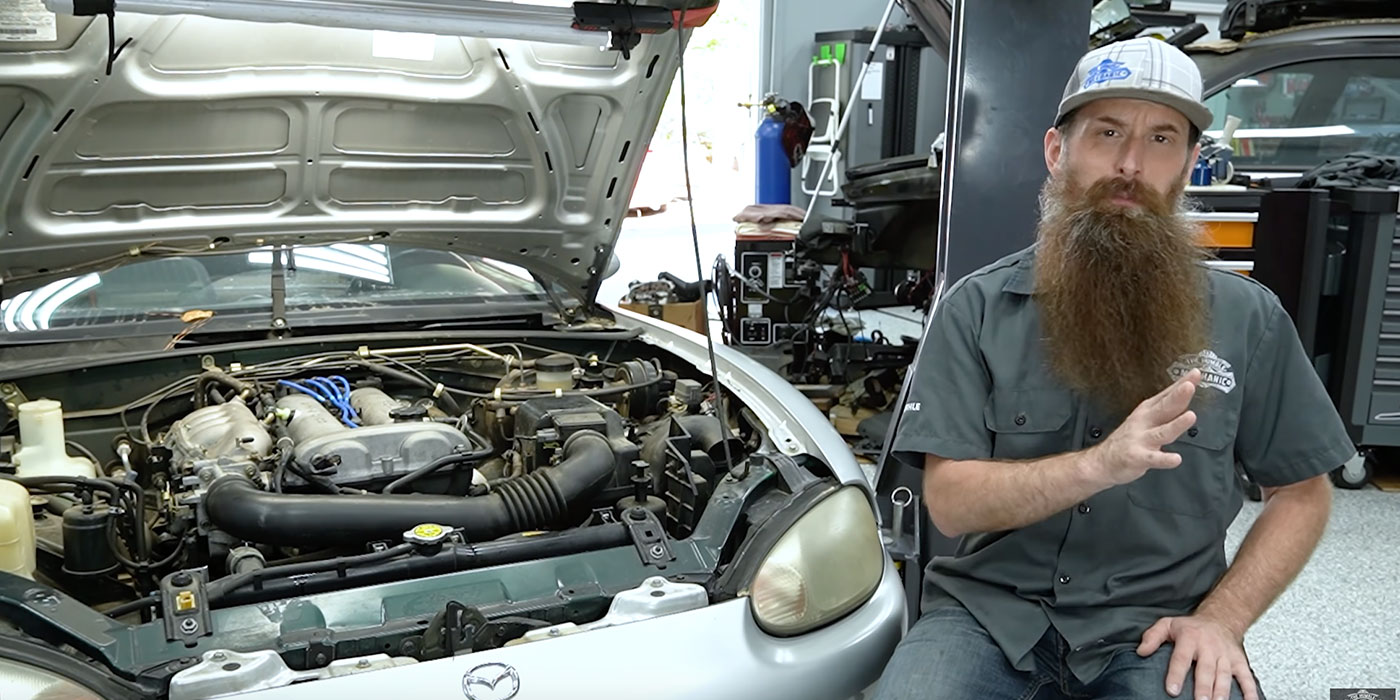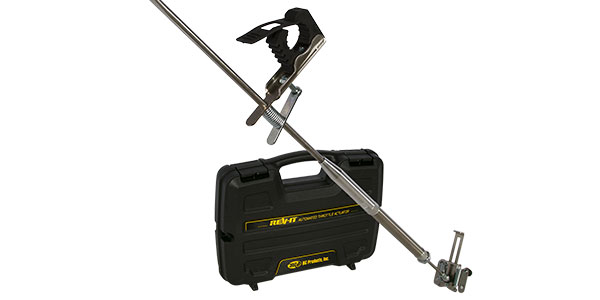Amazingly, up to a third of the heat energy produced inside an engine’s combustion chambers ends up as waste heat that goes into the block. This heat must be eliminated, otherwise the engine will overheat and self-destruct.
The water pump keeps coolant circulating between the engine and radiator to get rid of the heat. The pump is usually belt-driven and turns continuously while the engine is running. Most pumps are mounted on the front of the engine and are driven by a V- or serpentine belt. Some water pumps are mounted under the timing belt cover on OHC engines and are driven by the timing belt. A few are mounted on the back of the engine or head and are driven by the camshaft.
The water pump housing itself is usually made of cast iron, aluminum or stamped steel. Inside the housing is a paddle-style impeller mounted on a shaft supported by a bearing and seal assembly. The bearing assembly has two sets of bearings (ball or needle style) with a seal to prevent coolant from leaking out of the pump. The back of the pump housing may have a cover or bolt directly to the block, requiring a separate gasket.
Pump Function
On most engines, the pump pulls coolant in through the lower radiator hose and pushes it into the block. The coolant then flows up through the heads and returns to the radiator through the thermostat housing and upper radiator hose. On some vehicles, a “reverse flow” system is used. In this style of system, the water pump routes coolant into the head(s) first, and the coolant then circulates through the block before returning to the radiator.
The water pump also circulates coolant through the heater. The water pump typically has a second outlet that is connected by a hose to the heater core. The coolant then flows back to the engine or pump through a return hose. Some pumps also have an additional outlet port for a “bypass” connection that allows coolant to circulate through the block when the thermostat is closed.
Water pumps work hard, typically pumping several hundred gallons of coolant per hour at highway speeds. Because of the continuous load on the water pump, failures are not uncommon. The first symptom is usually significant leakage at the pump weep hole. More than a few drops of coolant coming out of the weep hole usually means trouble. Other symptoms include bearing noise (rumbling, chirping or growling), loss of coolant (through the leaky shaft seal), overheating (from coolant loss or separation of the impeller from its shaft) and fan wobble.
Pump Problems
One way to spot a water pump with bad shaft bearings is to check pulley or fan play with the engine off. The pulley or fan should not wobble or show any visible play when it is tugged on by hand. Suspected seal leaks can be diagnosed by pressure testing the cooling system.
If a water pump has reached the end of the road and needs to be replaced, you can offer your customer a new or remanufactured pump. Reman pumps typically include a new bearing and seal assembly but reuse the original impeller (unless it was damaged), shaft and housing.
Pump Replacement
Because of the variety in OEM pump configurations, make sure the replacement pump has the same mounting configuration, bolt locations and hose connections as the original. Also compare pump heights as these may vary depending on the dimensions of the timing cover or other belt-driven engine accessories.
When a water pump is replaced, the cooling system should always be drained, flushed and refilled with a fresh mixture of antifreeze and water to restore proper cooling performance and corrosion protection. Just draining the radiator can leave as much as 50% of the old coolant in the engine block.
Related Service
Belts and hoses should also be carefully inspected, and replaced if any are found to be in less than perfect condition. Hoses that are brittle, aged, cracked, bulging or chaffed must be replaced. New clamps should also be recommended. Belts that are frayed, cracked or glazed also need to be replaced.
On overhead cam (OHC) engines that use the timing belt to drive the water pump, check the mileage on the original timing belt. If the belt has been in service more than the OEM-recommended replacement interval (60,000 miles on older vehicles, and up to 100,000 miles on newer ones), the timing belt should also be replaced. This will save the labor of having to do the job twice because the timing belt usually has to be removed to install the pump.
If the engine has overheated because of a pump failure or loss of coolant, you should recommend replacing the thermostat, too. Overheating can damage the wax sensing element inside the thermostat, preventing it from opening properly at the right temperature.
Another component that may also need replacing is the fan clutch (if the vehicle uses one). The lifespan of the fan clutch and water pump are about the same, so if one has failed, many experts recommend replacing both components at the same time to reduce the risk of future cooling problems.
Other items you may need to purchase for the job include a gasket sealer or RTV silicone sealer, and thread sealer for any water pump bolts that extend into open water jackets in the engine block (to prevent leaks).
Tech Q & A: Water Pumps
Q. I found a little black stain running down the water pump weep passage on a late-model 2.7L Chrysler. Is that normal?
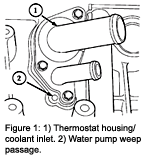 A. The AERA Technical Committee offers the following information regarding water pump replacement for 1998-2003 Chrysler 2.7L VIN R, U and V engines. According to Chrysler engine warranty administrators, many water pumps for these engines have been needlessly replaced.
A. The AERA Technical Committee offers the following information regarding water pump replacement for 1998-2003 Chrysler 2.7L VIN R, U and V engines. According to Chrysler engine warranty administrators, many water pumps for these engines have been needlessly replaced.
These pumps were replaced as the result of visual observation of traces of a thin black stain running down the pump weep passage as shown in Figure 1. According to Chrysler, a slight amount of stain below the water pump weep hole/passage is considered normal operation. Replace the pump only if a heavy deposit or a steady flow of engine coolant is evident from the weep passage. Also replace the pump if it shows bearing damage or cracking. See Figure 2 for bolt locations.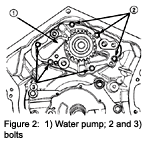 The water pump for this engine is an internal design and at least five hours of labor time is required for pump replacement. Technicians may find a replacement pump also weeps. Carefully monitor and confirm coolant level loss before replacing the water pump for this engine.
The water pump for this engine is an internal design and at least five hours of labor time is required for pump replacement. Technicians may find a replacement pump also weeps. Carefully monitor and confirm coolant level loss before replacing the water pump for this engine.
Q. I read somewhere about an issue with Ford Contour water pumps. Do you know of anything regarding that issue?
A. The AERA Technical Committee offers the following information regarding overheating of 1995-2002 Ford 2.5L VIN L engines (used in Contour and Mystique cars) caused by lack of coolant flow.
Many engine overheating problems have been traced back to shattered plastic water pump impellers found in the OE water pumps. It has been noted that aftermarket water pumps equipped with steel impellers have reduced the chance of engine failure due to overheating caused from lack of coolant flow.





